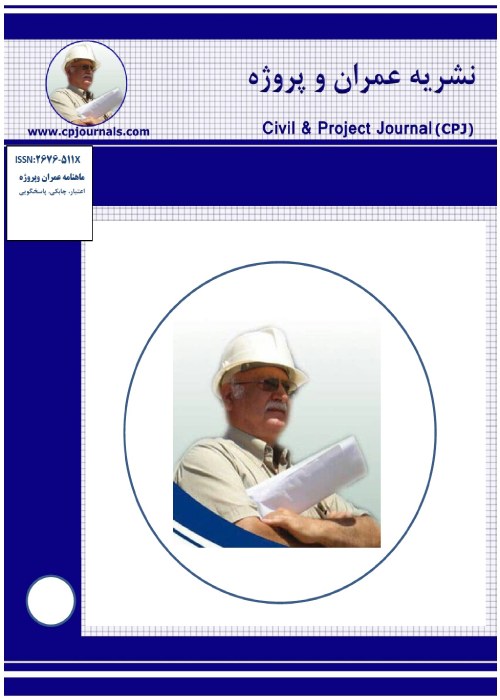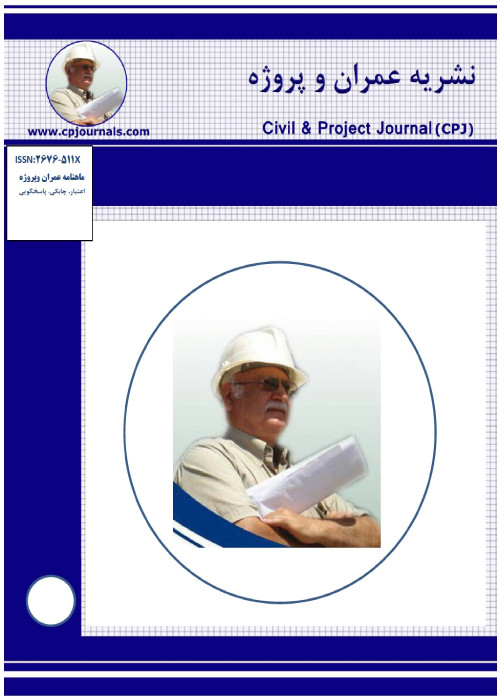فهرست مطالب

نشریه عمران و پروژه
سال پنجم شماره 2 (پیاپی 48، اردیبهشت 1402)
- تاریخ انتشار: 1402/04/24
- تعداد عناوین: 4
-
صفحات 21-32
بر اساس طرح مجوز مکانی- زمانی در شهر مشهد، تردد وسایل نقلیه سنگین و نیمه سنگین در محدوده های مشخصی از شهر که عمدتا شامل محدوده مرکزی می شود، تنها از ساعت 22 الی 9 روز بعد مجاز است. این امر موجب جایگزین شدن تعداد بیشتر وسایل نقلیه باری سبک با تعداد کمتر وسایل نقلیه باری سنگین و نیمه سنگین می شود و در صورت عدم اعمال طرح محدودیت زمانی - مکانی، با فرض ثابت ماندن تناژ بار جابجا شده، تعداد وانت ها کاهش یافته و تعداد وسایل نقلیه باری سنگین و نیمه سنگین افزایش می یابد. لیکن، میزان کاهش در تعداد وانت ها بیشتر از تعداد افزایش در تعداد سایرین است. هدف از این مطالعه بررسی نتایج اعمال محدودیت و تغییر در ترکیب ناوگان باری از نقطه نظر ترافیکی، زیست محیطی و ایمنی است. بدینمنظور از نسخه 8.01 نرم افزار شبیه ساز ترافیکی ایمسان استفاده شده است. در خصوص اثرسنجی تغییرات مذکور، دو سناریو شرایط وضع موجود و شرایط عدم اعمال محدودیت زمانی - مکانی شبیه سازی گردید و نتایج حاصل نشان داد که اگرچه در حالت اعمال محدودیت مکانی-زمانی، پارامترهای ترافیکی، زیست محیطی و ایمنی به بهبود می یابد اما این بهبود به میزان بسیار اندکی می باشد. این نتیجه را می توان ناشی از دو علت دانست: در بافت محدوده مرکزی شهر مشهد، شبکه معابر کم ظرفیت و سطح سرویس نامناسب می باشد، لذا حتی در صورتی که محدودیت اعمال نشود، وسایل نقلیه باری سنگین به جز در موارد ضروری تمایلی به عبور از این محدوده ندارند. همچنین با توجه به کنترل و اعمال قانون ضعیف و عدم در اختیار داشتن تجهیزات هوشمند کافی، تعداد تخلفات بالا بوده و این محدودیت به طور کامل اجرا نمی شود.
کلیدواژگان: محدودیت زمانی- مکانی، وسایل نقلیه باری سنگین و نیمه سنگین، وسایل نقلیه باری سبک، شبیه سازی ترافیکی، شهر مشهد -
صفحات 33-49
مقاومت بتن به عنوان یک پارامتر مهم می تواند نقش مهمی در رفتار و عملکرد سازه داشته باشد. لذا استفاده از بتن پرمقاومت می تواند موجب بهبود و رفتار عملکرد سازه شود، البته این به عنوان یک فرض می باشد که باید با آزمایش و مدلسازی دقیق بررسی شود. در این مقاله به بررسی اثر مقاومت فشاری بر روی رفتار سازه بتنی پرداخته شده است. در این پژوهش سه قاب با تعداد طبقات 5، 10 و 15 طبقه که دارای سیستم، قاب خمشی از نوع متوسط می باشد برطبق استاندارد(2800) و مبحث نهم مقررات ملی طراحی در نهایت تحلیل دینامیکی غیرخطی بر روی مدل اعمال می شود. تحلیل و طراحی قاب ها به کمک نرم افزار ETABS انجام گرفت. در این مطالعه پارامتر تنش فشاری بتن به عنوان متغیر اصلی مدنظر می باشد و دو نوع بتن سبک با مقاومت 25 مگاپاسکال و 55 مگاپاسکال در نظر گرفته خواهد شد. بعد از بدست آوردن مقاطع سازه مورد نظر در نرم افزار OpenSees کدنویسی شده است. برای بدست آوردن منحنی های شکنندگی از 10 عدد رکورد استفاده شده است. با بررسی نتایج مربوط به بتن سنگین و سبک نیز مشاهده می شود که در هر سه سازه مورد مطالعه (پنج، ده و پانزده طبقه) سازه با بتن سنگین دریفت کمتری در PGA یکسان با سازه که دارای بتن سبک داشته است با یک میانگین گیری از نتایج مشاهده شده است که سازه با بتن سنگین تقریبا در محدوده 15 تا 24 درصد جابجایی نسبی کمتری نسبت به سازه با بتن سبک داشته است.
کلیدواژگان: بتن پرمقاومت، تحلیل دینامیکی غیرخطی، قاب خمشی متوسط، سازه بتنی، منحنی شکنندگی -
صفحات 50-73
خرپا پیچیده سازه ای است متشکل از واحدهای مثلثی که از اتصال اجزای باریک و بلند که در انتها با مفصل به یکدیگر متصل شده اند ساخته می شوند. این گونه سازه ها به دلیل توانایی انتقال نیرو در فواصل و دهانه های بلند بین تکیه گاه، کاربرد وسیعی در سازه های ساختمانی و صنعتی دارند. نیروی اعضای خرپاهای مبهم و پیچیده بر خلاف خرپاهای ساده و مرکب، تنها با استفاده از معادلات تعادل قابل محاسبه نمی باشد. در سال های گذشته از روش های هنبرگ و کار مجازی که از اصول تحلیلی مشابهی تبعیت می نمایند برای تحلیل و محاسبه نیروی اعضای خرپاهای مبهم استفاده شده که در این روش ها برای محاسبه نیروی اعضا می بایست خرپاهای پیچیده را دوبار تحلیل نماییم که محاسبات آن ها بسیار طولانی و وقت گیر می باشد. در روش جدید ارایه شده در این مقاله، دیگر نیازی به تحلیل دو و یا چند باره خرپای پیچیده نبوده و در زمان کوتاه تر و با نوشتن معادلات تعادل کمتر و با یک بار تحلیل سازه، نیروی اعضای خرپای مبهم بدست می آید. از دیگر مزایای این روش جدید، کنترل محاسبات انجام شده در هر مرحله بصورت مستقل می باشد. این روش علاوه بر خرپاهای پیچیده معین، توانایی تحلیل خرپاهای پیچیده نامعین و قاب های مفصلی ساده با مهاربندهای همگرا را نیز دارد که سایر روش ها این قابلیت را دارا نمی باشند. در این روش جدید نیروی همه اعضا با یک بار تحلیل خرپا بدست می آید.
کلیدواژگان: خرپای پیچیده، تحلیل سازه، معادلات تعادل، قاب ساختمانی ساده، مهاربند همگرا
-
Pages 11-20
Concrete can be assumed as the most regular constructional material in the world, which has a lot of advantages as well as disadvantages that attracted the attention of researchers. Adding natural materials including silica fume, fly ash, rice husk ash, metakaolin, and natural fibers and animal waste to concrete can improve the fresh and hardened properties of concrete such as slump, strength, water absorption, and durability, and at the same time reduce the environmental effects. On the other hand, adding too many natural additives can cause adverse effects on concrete, such as reducing efficiency and increasing curing time, which can be compensated by adding different kinds of fibers to the concrete mixture. In order to add natural additives to concrete, several experimental and field tests were performed, in which the effects of natural additives on the properties of concrete and their long-term performance were evaluated. Reducing the carbon footprint, and increasing resistance to cracking and corrosion are among the advantages of natural additives. In this paper, a review was conducted to evaluate the influence of natural additives on the mechanical properties of concrete specimens including compressive strength, flexural strength, and water absorption. The overall effects of utilizing natural additives on concrete properties were reviewed and listed accordingly.
Keywords: Natural Additives, Rice Husk Ash, Natural fibers, Animal Waste, Blast furnace slag, curing time -
Pages 21-32
According to the temporal-spatial limitation plan in Mashhad, the traffic of heavy and semi-heavy vehicles in certain areas of the city, which mainly includes the central area, is only allowed from 10:00 PM to 9:00 AM. This leads to the replacement of more light cargo vehicles with fewer heavy and semi-heavy cargo vehicles. On the other side, if this limitation plan is not applied, assuming the constant tonnage of the transported cargo, the number of pickups will decrease while the number of heavy and semi-heavy cargo vehicles will increase. However, the decrease in the number of pickups is more than the increase in the number of others. The main purpose of this study is to investigate the results of restrictions and changes in the composition of the cargo fleet from the traffic, environment and safety point of view. For this purpose, version 8.01 of Aimsun traffic simulator software was used. To evaluation of the effectiveness of the mentioned changes, two scenarios were simulated: the existing situation and the condition of not applying temporal-spatial restrictions. The results showed that in the case of applying restrictions, traffic, environmental and safety parameters are improved. But this improvement is very small. This can be seen as the result of two reasons: most of the road network in the central area of Mashhad is low-capacity with an inappropriate level of services, therefore, even if the restriction is not applied, heavy goods vehicles, except in necessary cases, don't willing to cross this area. Also, due to the weak control and the lack of enough smart equipment, the number of violations is high and this plan is not fully implemented.
Keywords: Temporal-spatial limitation plan, heavy, semi-heavy cargo vehicles, Pickups, Traffic simulator, Mashhad City -
Studying the Impact of Near and Far Earthquakes on Concrete Buildings with Structural Light ConcretePages 33-49
Concrete strength as an important parameter can play an important role in the behavior and performance of the structure. Therefore, the use of high-strength concrete can improve the performance of the structure, of course, this is an assumption that must be checked by testing and modeling. In this article, the effect of compressive strength on the behavior of concrete structures has been investigated. In this research, three frames with 5, 10, and 15 floors, which have a system, a medium-type bending frame according to the standard (2800) and the ninth topic of the national design regulations, finally, nonlinear dynamic analysis is applied to the model. The analysis and design of frames was done with the help of ETABS software. In this study, the compressive stress parameter of concrete is considered as the main variable, and two types of light concrete with a strength of 25 MPa and 55 MPa will be considered. After obtaining the sections of the desired structure, it is coded in OpenSees software. 10 records have been used to obtain fragility curves. By examining the results related to heavy and light concrete, it can be seen that in all three studied structures (five, ten and fifteen stories), the structure with heavy concrete has less drift in the same PGA as the structure with light concrete, with an averaging of the observation results. It has been found that the structure with heavy concrete has less relative displacement in the range of 15 to 24% than the structure with light concrete.
Keywords: high strength concrete, Nonlinear dynamic analysis, medium bending frame, concrete structure, Fragility curve -
Pages 50-73
A complex truss is a structure consisting of triangular units made up of long, narrow components that are joined at the end by a joint. Such structures are widely used in construction and industrial structures due to their ability to transmit force in long distances and spans between supports. The force of members of complex trusses, unlike simple and compound trusses, cannot be calculated using equilibrium equations alone. In recent years, Henneberg and virtual work methods that follow similar principles have been used to analyze and calculate the force of members of obscure trusses, in order to calculate the force of the members, the complex trusses have to be analyzed twice, their calculations are very long and time consuming. In this new method, there is no need to analyze the complex truss two or more times, and in a shorter time by writing less equilibrium equations and with one analysis structure, the force of the complex truss members is obtained. Another advantage of this new method is the control of calculations performed in each step independently. In addition to certain complex trusses, this method also has the ability to analyze indeterminate complex trusses and so simple hinged frame with concentrated brace, which other methods do not have this capability. This new method the force of all members is obtained with one analysis of complex truss.
Keywords: Complex Truss, Structure Analysis, Equilibrium equations, Simple Frame Structure, Concentrated Brace


